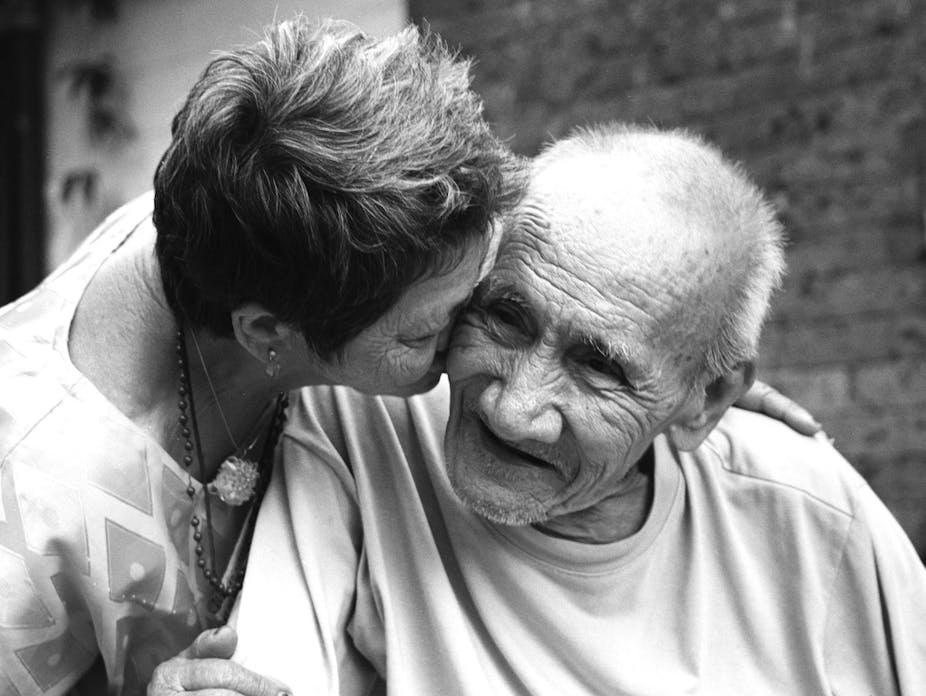A quiet but significant conversation about caring started across all levels of government and parts of the non-government sector this year. It emanates from two key reports from the Productivity Commission – on aged care and disability services – that will shape policy over the next decade or more.
Of course, some of us talk about these matters all the time but, at crucial junctures, the clamour for change grows louder and more insistent in policy circles. We ask: whose job it is to provide care and in what manner should we look after those who are dependent because of disability or old age?
The current consensus is that government must provide specialized services. Indeed, the past 30 years have seen the scope of services extend as more people with a wider range of conditions have become reliant on them. Funding has similarly tracked up.
For disability services (covering those aged under 65 and including people with long-term psychiatric disabilities), the Productivity Commission’s Disability Care and Support report advocates establishing a national scheme by 2017. This is to be funded from consolidated revenue at a 100% increase from current funding levels.
The Gillard government committed to the development of a National Disability Insurance Scheme (NDIS) in August and set up a select council of COAG with a sectoral advisory group (of which I am a member) appointed in late 2011.
Aged care came under scrutiny at the same time. The National Health and Hospitals Reform Commission, an independent policy advice mechanism set up in the very early days of the Rudd government, identified a need for a Productivity Commission inquiry into aged care, building on the many reports and reviews of the sector, and national consultations.
This report, Caring for Older Australians, was released in August 2011 with the government committing to reform on the basis of four overarching principles:
entitlement (older people deserve quality support)
increased choice and control
creating a system that’s sustainable and fair
care being provided by a trained workforce
While information about the reform processes in this sector remains vague, these principles provide an effective link back to the disability reforms.
Unfortunately, these brief maps of landmarks in current ageing and disability reforms are inadequate because they leave out key developments and don’t capture all interrogation of current policy and proposals for innovation.

They fail to convey the extent and, at times, heat of the policy debates, the pathos of public consultations and the apprehension from all parts of the sectors about what some are calling root-and-branch reforms. And they leave out historical analysis, a record of the community-based campaigns, and the naming of the champions and resisters.
Putting aside the wider conversation about the place of informal, family and community-based caring to focus on the role of government in service design and funding, we can see that both reports of the Productivity Commission reflect a shift in thinking: away from remnant institutional service modes toward more individualised, personalised and market-driven models of service delivery. This is based first on rights-based notions of entitlement to services and supports and second on arguments about choice and control.
The Productivity Commission has heeded the feedback from the users of services about the impact of unmet need, being placed on waiting lists for services, and inadequately trained staff. None of this is new.
We’ve known for a long time that inappropriately designed and delivered services control and constrain individuals and their families, that tight funding models lead to service rationing, and that governments have become increasingly anxious about escalating costs of provision.
But are arguments about rights and choice sufficient to carry the necessary reforms?
As I prepare to enter the next five years of work to implement the NDIS, I’m excited about the possibility of bringing more appropriately allocated and designed resources into the lives of disabled and ageing Australians. For many these resources will bring the power to be more independent and to move into an ordinary life as a valued member of our community. This is a powerful investment in their future.
Those with a combination of impairment, long-term disadvantage, and oppression within service face additional problems. They don’t enter this welfare-market world with vision, self regard, high expectation and bargaining power. As a result, they will continue to bump up against the discrimination that seems hard-wired into our collective lives.
Services that are well-funded, well-designed and delivered with a soft touch in a timely way will do much to open up new vistas and opportunities for these citizens. But notions of rights and choice will not be strong enough to carry a more profound agenda of inclusive community-building. Nor will they create the recognition that caring at its broadest involves relationships founded in valuing the person, their rights, needs, aspirations and capacity for mutual regard.
Without a national conversation wrestling these difficult philosophical and political issues, discrimination, exclusion and oppression could continue well into our future.
Such processes have been part of our national life for almost 200 years. A changed funding model will do much to shake them up, but it won’t put them to rest until we are able to agree that older people and those with disability belong alongside us in all the shared pathways of our lives.

